Northern Italy
From 2000 m to sea level: the Dolomites and Venice
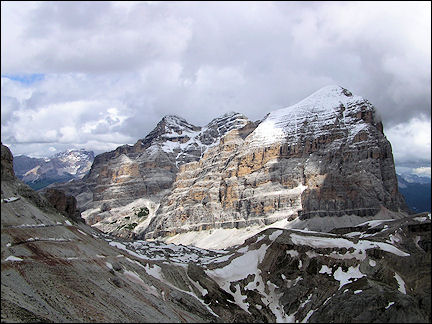
|
Hiking sky high in the Dolomites, once surprised by a summer snow storm, but the rest of the time the sun shines on the breathtaking landscape. Climbing along marked trails to mountain peaks and sunbathing on grassy slopes. The contrast with Venice couldn't be sharper - extremely touristy spots are out of the question after the peace and quiet of the mountains, but there's a lot to see in less well-known parts of the archipelago.
Travelogue & photos: Michelle Spaul
In search of a good break with plenty to do and lots of freedom, I took the advice of a friend to head to Northern Italy, flying into Venice Marco Polo and then heading into the Dolomites to the Tyrolean style valleys nestling under the unique peaks of Dolomitic limestone.
Mount Pizac
Relics of World War I
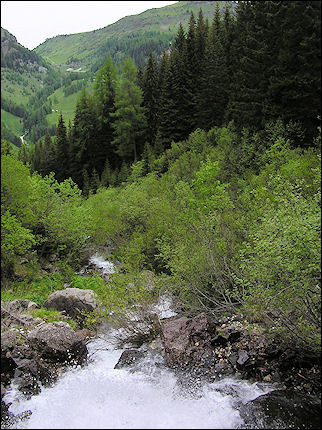
|
In the Dolomites I stayed in the small resort town of Arraba, about 50 km from Cortina d'Ampezzo and had a range of activities at my fingertips. As I was concerned about my fitness I decided to take it easy on the first day and looked towards the Sella Massif for a gentle stroll.
Heading to the head of the walk, my attention and ambition were captured by a mountain on my right, Pizac, and I soon found myself heading in the opposite direction, taking a path through woods and across ski piste to the valley of Chel Vesco. Only overused words such as breathtaking and awe inspiring can adequately describe the sight of the valley and its magnificent mountain guards. The sun had broken through the clouds and by now I was keen to lie on the soft grass and commune with nature.
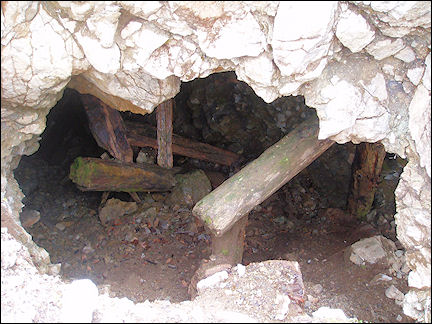
|
After a suitable rest I continued my ascent to the top of Pizac and encountered relics of World War One for the first time. As the marked path heads towards the summit and soon to be familiar crucifix, the marmots play and shriek. The hill is scarred; soldiers carved out trenches and the small cave-like dugouts that would become their homes for many months.
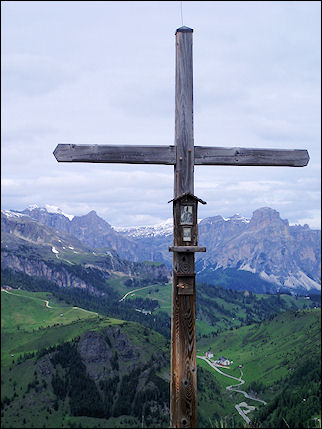
|
Near the top of Pizac I started to walk along 'convenient' paths all too aware that this was the Italian / Austrian front and my way was made easier through the soul-destroying efforts of hundreds of soldiers.
The exposed peak of Pizac towers over Arraba, its crucifix visible on a clear day. It seems that this piece of land had less value than the face I ascended, as the meadow lands were not crossed with trenches. My sombre mood was swept away in the brisk breeze and the uplifting views.
The presence of many alpine flowers was a handy excuse to stop and take a breath and this was to become a feature of my trip.
Via Ferrata on the Gardena Pass, Cir Spitz
Snow in the summer
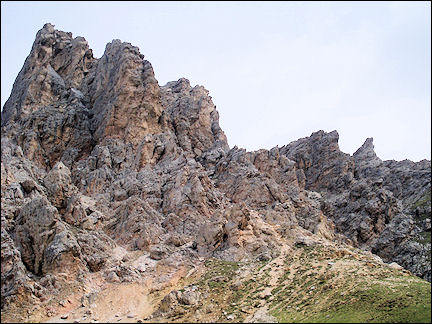
|
On the second day my confidence was much higher and the need to visit more peaks spurred me into joining a group who were undertaking an introductory Via Ferrata on the Gardena Pass peak of Cir Spitz - a grade 2a, which means that the technical difficulty of the climbing was fairly easy - little more than scrambling - and the walk in was short and undemanding.
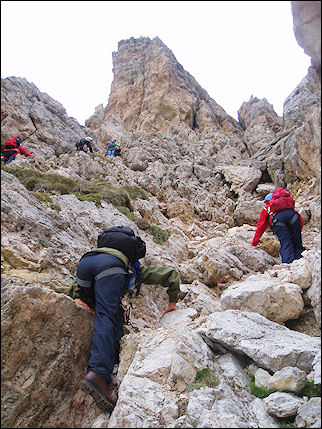
|
Via Ferrata requires some specialist equipment, a full body harness, a helmet and a special set of ropes and karabiners. These are put on at the last possible opportunity, but still had to be worn on the long scramble to the ladder that marked the start of the Via Ferrata. The scramble was fun and woke up my sense of adventure as the group spread out and we were able to pick our own paths through the rocks.
Once at the Via Ferrata the kids in the group were keen to get going, so we graciously let them shoot up to the top while us older folk took a more sedate pace. As we climbed there was much talking and a little banter. We handed cameras back and forth as we spotted the most exciting shots and everyone passed on guidance and words of caution.
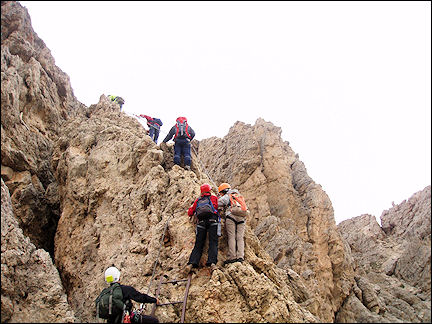
|
Most of all we noticed the weather closing in. The only way was up, but the actual summit is optional and we wanted to get there before white-out conditions could stop us making it to the top.
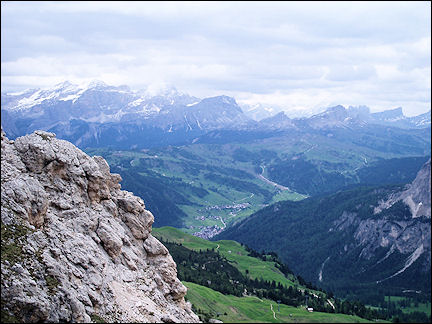
|
Lunch saw us perched just below the summit and the promise of food brought the acrobatic choughs. Related to the crow, these birds are clever and brave, parading for crumbs, moving from group to group, person to person until a or two morsels are thrown.
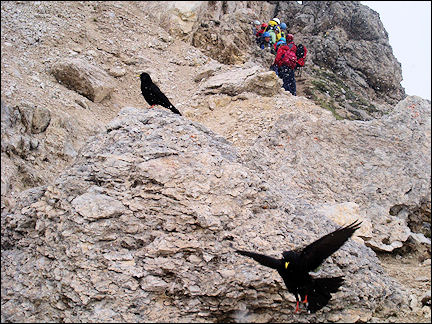
|
The climb to the summit is straight up a 10 metres stump of rock, with only enough room for ten at the top, so we waited our turn as the kids celebrated their ascent. The weather arrived and before we knew it our summer holidays were given a snowy blanket.
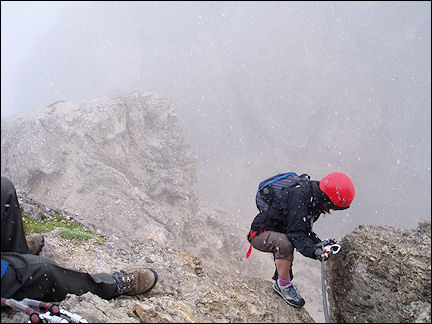
|
Waiting for our turn to climb the summit had been cold and wet, so we quickly pushed up, looked at the clouds and then returned to the path. The descent was long and difficult, requiring cabling at some points (called a protected path), still the company was good and we soon caught a rhythm, returning to our vehicles in good spirits.
Sassongher
Tarzan style across a gap
The next day I ventured out in a much smaller group to see if we could achieve the summit of Sassongher. This is a rocky outcrop above the village of Colfosco.
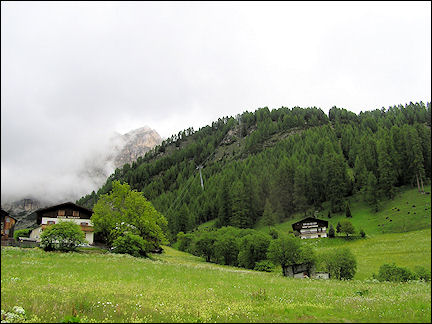
|
The weather forecast and existing conditions (a lot of snow on the summit) meant that there was a chance the walk would stop short at saddle a little way below the protected path and summit, but I felt it was worth the risk to get a crack at this majestic mountain.
The walk from the village was gentle and green, the grass of the ski pistes was lush and trees nestled in protected nooks. At the end of the winding path we had two options, climb onto the nearby plateau of many peaks or to strike up the exposed flank of Sassongher.
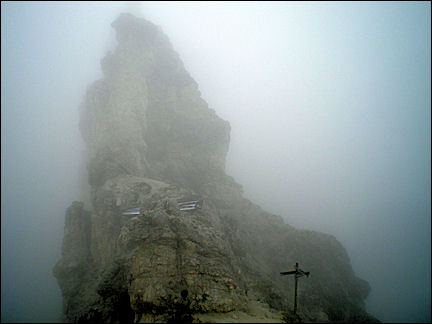
|
As there had been no cabling to this point I was keen to go up and was glad that this was the mood of the group. As with each of the walks I had taken so far, there were clear and frequent way markers on the path - small blocks of red and white striped paint looking like flags planted by explorers.
After an interesting set of switch backs, which brought ever-changing scenes into view and a wealth of waterfalls and various stones and mineral deposits, we reached an imposing peak - it looked impenetrable, and yet there were the remains of a wooden structure - perhaps another reminder of the war. We turned to the right and started up a snow field.
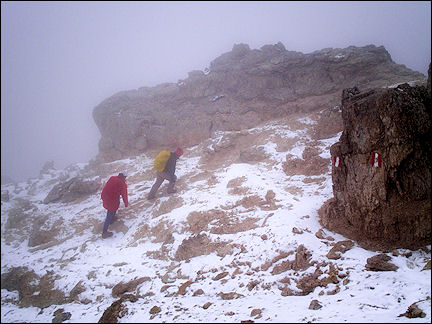
|
Careful foot work was required now and after leaving our footprints in the pristine snow we eventually came across the cable that led us nearer to the top. The protected path was great, the cable mainly showed the way and offered a hand hold if the going got tough, for the most part I did not need it for support.
Except when the ledge had fallen and the required jump was too far for my little legs. Tarzan style - okay, both ends of the cable were secured, but I did give a triumphal yell - I swung across the gap. No points for style, but I am here to tell the tale! By now it was really cold and my camera froze, refusing to respond to any command or cajoling, luckily a fellow walker sent me his photos...
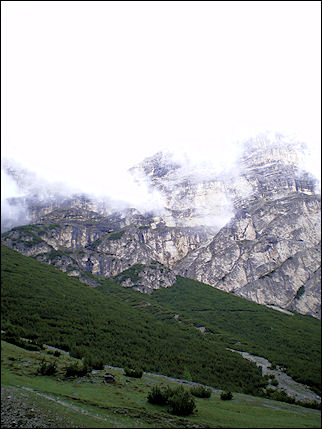
|
We didn't summit on Sassongher. As we trekked across snow fields, we felt safe while we could see the little flags of the conquering Alpine Club of Italy, as they were painted on vertical stones. As we got nearer to the top there were no vertical stones and the flags were covered in several inches of snow, we couldn't even see the summit or the very likely crucifix. Common sense prevailed and we turned back - the cabled section was as much fun on the way down and its end marked our lunch spot.
Walking back was a gentle affair with much chat, when the clouds temporarily dispersed we caught glances of the majestic mountain.
Strobel Via Ferrata
A little more taxing
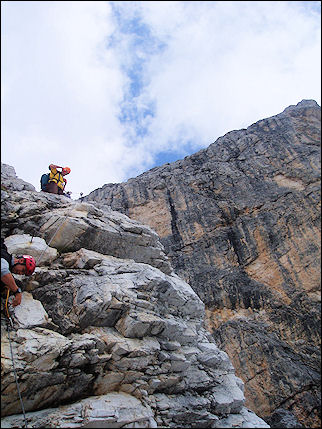
|
Taking the introductory Via Ferrata of Cir Spitz, was recommended to ensure that I could cope with exposure - a gentle euphemism for paths along the face of mountains with very large drops. I was happy to have passed that test, as it meant I was okay to join the outing to a Via Ferrata of grade 3b - some technical climbing and a more exacting walk in. The Strobel Via Ferrata clings to the side of Punta Fiames and is named in memory of Michielli Strobel, an alpine guide.
The walk passed through a wonderful wooded slope and then wound to the base of the Via Ferrata. We walked quickly to get to the start of the climb and then hit three very vertical straight sets of cables and a ladder, with short winding walks between. It was amazing and totally absorbing.
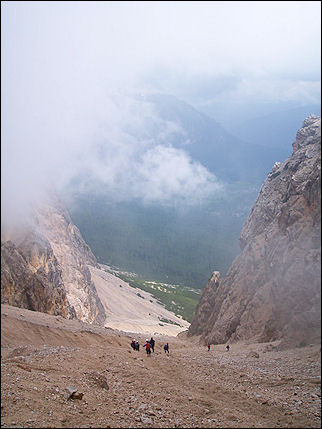
|
We strained to spot the promised views of Cortina d'Ampezzo throughout the walk, and occasionally the clouds broke and presented the valley below in its splendour. Despite a blanket of impenetrable cloud, lunch at the summit was jovial and set the scene for much camaraderie as we trekked along a fairly exposed ridge with some hair-raising traverses.
Then the group really let go, the descending path hit a huge scree run and we made incredible time bounding and sliding down the mountain side. The end of the descent was back through the woods and for the first time the weather really let rip as the rain poured down. We arrived back at the car rather damp, but definitely elated.
Lagazuoi tunnels
Incredible labyrinths dug by Austrians and Italians
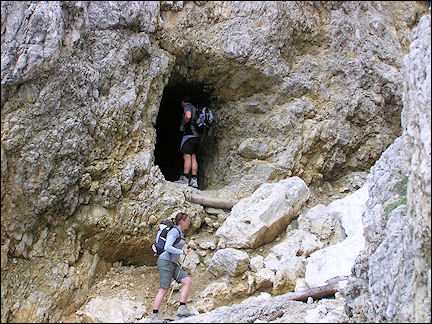
|
It was hard to believe that my time in the Dolomites was nearly over and instead of a planned day relaxing in a spa I accepted an invitation to visit the Lagazuoi tunnels. The 'war of the tunnels' took part under the Lagazuoi mountain, where both the Austrians and Italians dug out incredible labyrinths, with look-outs at strategic points.
Both sides attempted to blow up the rocks below the other, in order to progress the front a few metres.
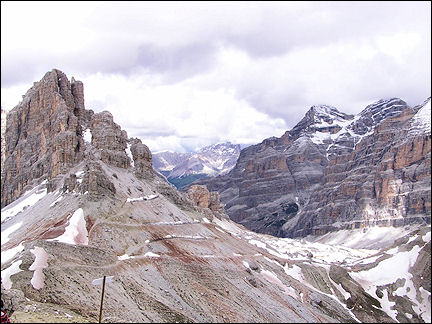
|
We bought maps at a tourist booth at the bottom of the mountains and were given the advice to go up by cable car or a troop path and down the tunnels to avoid the potential of rain in the afternoon; however, we decided to follow previous advice and to go up the tunnels.
The tunnels start someway up the side of the mountain, the route up there gives amazing views and has exposed sections with cabling. As we entered the caves, the cold and darkness were more notable as the sun had come out.
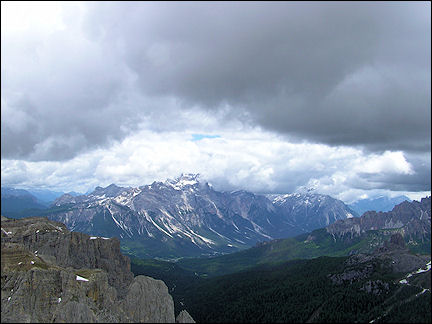
|
We climbed and wandered in the tunnels taking much advantage of the cables provided as hand rails, and grateful for the wooden steps recently added. Fairly often we encountered people heading down.
At regular intervals we stopped to admire the view from various look-out points - in the war they were used to keep an eye on the enemy and on supply chains, which brought tons of food, coffee and wine to the men who spent the war digging through the limestone.
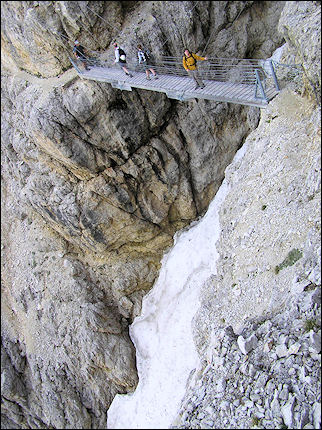
|
There were several points were it was possible to go outside and we ate lunch in the sun. From our lunch spot our midway point, a Refugio, was a tantalizing hundred or so metres away, all the more frustrating when we realised that we had climbed too high in the tunnels.
Going underground once more we followed signs for the Anti Clima and found that the advice to go up in the tunnels was excellent as going down the steps takes an inordinate amount of concentration and is very tiring. Coming out of the tunnels was breathtaking and after a bit of a climb through more trenches we reached the Refugio, where the view is truly 360° and, unlike the other summits on this trip, we could see for miles as the sun was out.
A team discussion determined that we all wanted to walk down the troop path - a three hour extension to our time on Lagazuoi, largely motivated by the desire to cross a suspension bridge half way down. We started by climbing to the summit, across a snow field to a particularly gothic crucifix and a set of Buddhist prayer flags and then we pursued the descending path. The whole walk was fantastic, we scrambled across scree, inched across snow that looked like frozen rivers and clung to cables as we tottered along tiny ledges.
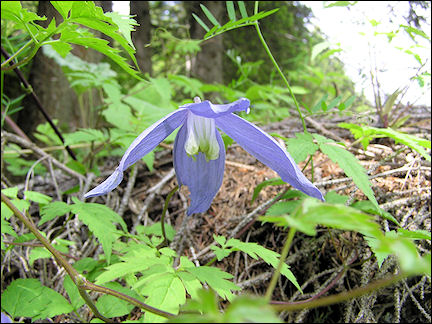
|
The bridge was brilliant, it was sturdy and strong and dwarfed by the gorge that it spanned. As we got to lower altitudes we found plenty of Alpine flowers, thus completing that day in the dolomites.
I had signed up for a walk advertised as 'hard' for my final day, but really I wanted to explore the Tyrolean nature of my temporary home. So I headed back up into the woods I walked though on my first day with the intention of hitting a small river that runs through the Pass, picking up snow melt on its way.
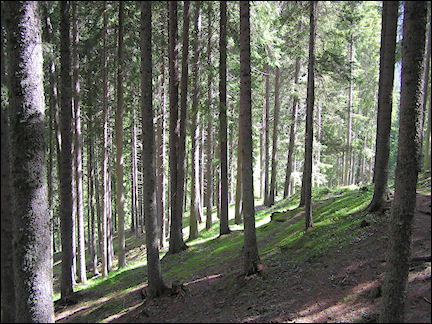
|
The good thing about valley walking is that there is no need for a map, just a sense of adventure and a willingness to back track when a seemingly good path turns into a dead end.
The woods above Arraba have two notable features when compared to coniferous woods in the UK. The first is the fitness trail, encouraging users to undertake lunges and tottering along a balancing beam among other exercises. The second is that the trees are not planted in straight lines nor harvested in great swathes, leaving behind scenes of destruction.
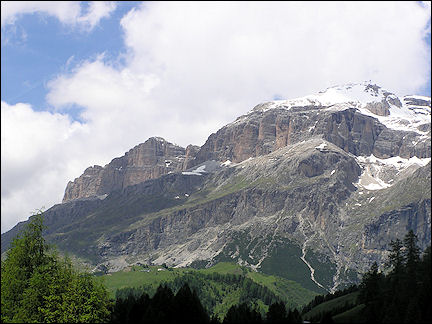
|
My experience of woodland management in the Dolomites was of lone men working in the woods to clear a small number of trees, stacking the wood for drying and making sure every part of the tree is consumed or returned to nature, through numerous stacks making habitats for wood-land animals as they decompose.
Dropping down the river meant a significant change in terrain, the trees thinned out and bog plants started to dominate, the drier areas provided a wonderfully accommodating mattress for a little mid-day snooze. The last part of my walk out was along the road to the small hamlet of Pezzei, where I ate in a local restaurant.
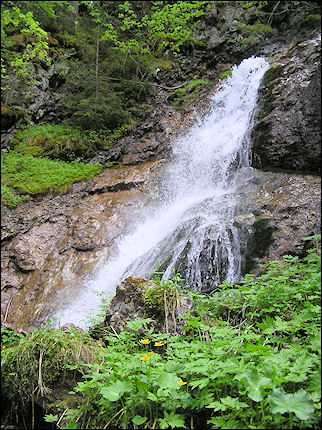
|
Returning, I tried to avoid the road and took a long detour along the hillside to the south of Pezzei. On this path I found a splendid post-prandial spot in a meadow and a wonderful waterfall. Attempting to transverse the hillside through a wood soon ended in failure and a retreat back to the road.
The last part of the walk was notable for the plethora of German bikers who had come to the Dolomites to explore the mountain roads. I hopped over the crash barriers and walked on the top of the concrete wall that marked the high water point of the river. As soon as it was possible I took off my boots and socks to paddle. I have never experienced so much pain in my life as I tried to stay in the water as long as possible. About thirty seconds later I leapt onto a suitable rock and wiped away the tears…
My final day in the Dolomites ended with a beer and ice cream in the centre of Arraba, a suitable end point for my time in the mountains and a good way to ready myself for Venice.
Venice: the island of Guidecca
Old warehouses, wharfs and boat yards
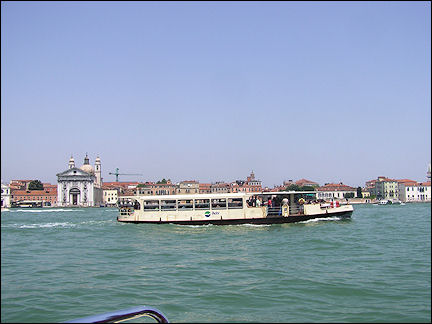
|
The trip to Venice was long and varied as the many faces of the Dolomites showed on the winding road. My first afternoon in Venice was a bewilderment of people and boats as I navigated my way to my apartment on the island of Guidecca.
It was much hotter in Venice and I soon realised that the crowded tourist haunts would not suit the mellow mood I had established in the mountains. I mainly spent time wandering the back streets of the main island and travelling around the lagoon on vaporetti and the ferry.
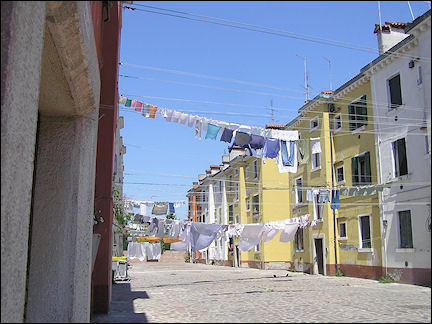
|
Venice is special; it is haunting and beautiful and with a bit effort to head away from the areas immediate to San Marco square, the crowds and tourist shops are soon left behind.
During my time in Venice I stayed on Guidecca; this island is constructed in a way that reflects it position relative to the rest of the islands. The side facing the main island of Venice is well developed with shops and restaurants, homes and gardens can be found in small alleys and back streets.
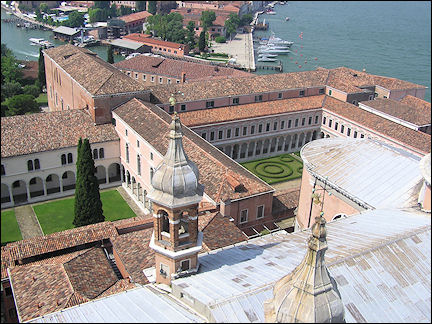
|
The other side of the island, facing the Adriatic and the island of Lido, is not fronted and the canals that link the two are industrial in character, old warehouses, wharfs and boats yards are common.
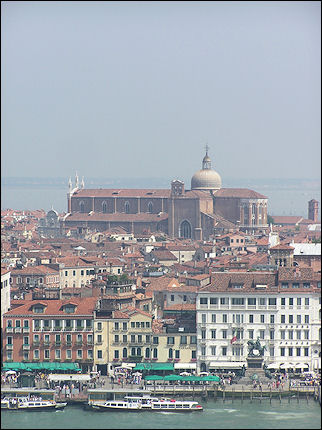
|
At one end of the island the Hilton Stucky provides up-market accommodation in a converted flour mill and at the other end, medieval churches and bridges punctuate the canal front (Canale della Guidecca) and a short vaporetto ride reaches the church and monastery of San Giorgio Maggiore.
This church is amazing with incredible artwork, statutory and choir, but to beat the lot you pay to take the lift to the top of the bell tower.
From the four sides of the tower you can variously see out to sea and the island of Lido, over Guidecca, the main island of Venice - including a bird's eye view of St Marks - and over the lagoon to the smaller islands.
San Zaccaria
Wedding pictures at the Bridge of Sighs
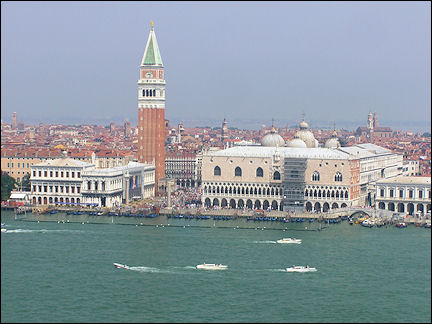
|
To get to the main island, the best transit stop is San Zaccaria, which is next to the San Marco stop, but has more options for travel and slightly fewer stalls with the inevitable masks, scarves, baseball caps and Chinese replica Venetian glass jewellery.
However, it also has the peculiar spectacle of wedding parties having their photos taken in front of the Bridge of Sighs - so named, not for the exquisite bliss of the marital bed, but rather for the noise made by prisoners taken to and from interrogation.
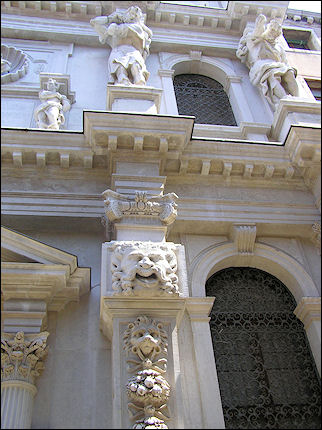
|
From the San Zaccaria stop it is possible to catch the No 1 vaporetto along the Grand Canal to Pizzale Roma, hop off and take the return journey, enjoying the wonderful buildings and history of the other bank. If you are lucky and quick, you can even get a coveted seat at the front or bank of the boat.
A short walk through San Marco square will take you to less-travelled streets, where the eagle eyed - or those with good guide books - will spot a wealth of unique buildings, churches and ornaments. Principle to the medieval structure of Venice is the linking of over one hundred low lying swampy islands with bridges, constructing canals and small squares or Campos to accommodate numerous communities.
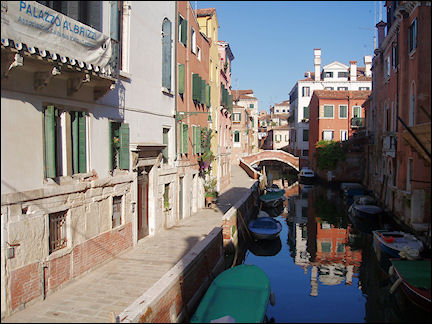
|
There are six regions to the main island, each with their own character and features. In a day of wandering I only touched San Marco, Santa Croce and Cannaregio. In this time I often only walked with Venetians, though I also made a point of visiting the Rialto Bridge.
The Campo structure means that churches are frequent and numerous; if you don't wish to queue for the Basilica there are umpteen opportunities to experience many types of church architecture.
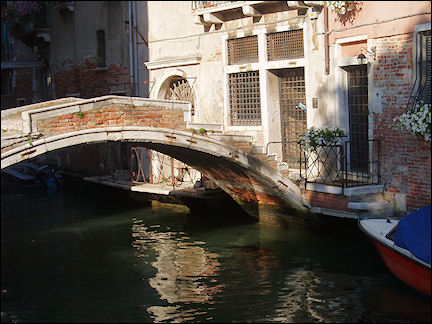
|
I had headed north with the desire to Fondemento Nuove and catch a boat to Murano, but in the end I spent too long with my eyes in the air and finally walked back to San Zaccaria to go back to Guidecca to eat.
Lido
Exploring by bike
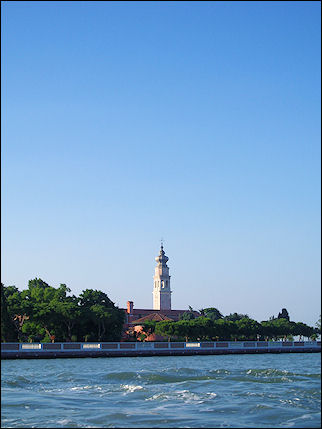
|
For the most part my other days were spent on the water. One day I travelled out to Lido, past the islands of San Servolo and San Lazzaro degli Armeni, but really that was an excuse to enjoy the ferry. The ferry sets out from Ferrovia, travels relatively sedately through the Canale della Guidecca and finishes its journey at Lido. Compared to the vaporetti, the ferry is a vastly different way to see the area and well worth the effort to get out to Ferrovia to catch.
Once on Lido I hired a bike and set off in search of the famous beaches. As Lido has cars, the ride is simultaneously easier than cycling in Venice would be - fewer pedestrians not paying attention - and a touch harder for a Brit used to riding on the left side of the road - still I escaped mishap and enjoyed the contrasting urban and coastal areas.
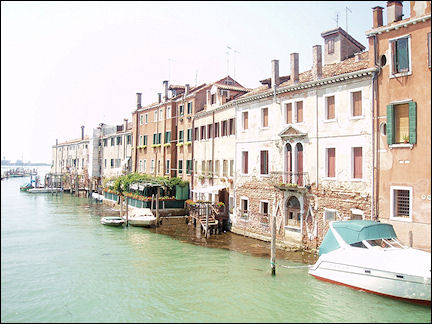
|
Finally reaching the ferry port at the south end of the island (Pellestrina Chioggina) I viewed a historic fort and got lost in the golf club before finally hitting the beach - of course there are beaches much closer to the Lido station, but I needed to make the most of my bike hire.
I had hoped to stop on one of the islands on the way back from Lido, but the water bus did not stop at San Lazzaro, my first choice and there was an awful lot of confusion at San Servo, where 20 or so people elected to not get onboard.
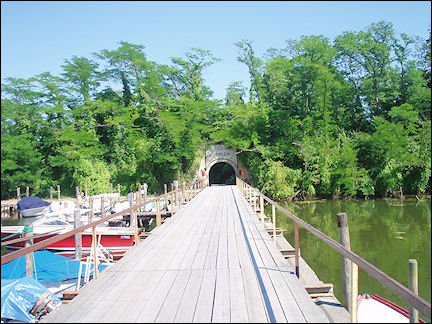
|
At San Zaccaria I stayed on the waterbus and headed back to Lido, to the horror of the 20 people on San Servo we sailed on by and I was convinced that the conductors on these buses are not altogether friendly to tourists…
Murano, Burano and Torcello
Ferry hopping from one island to the next
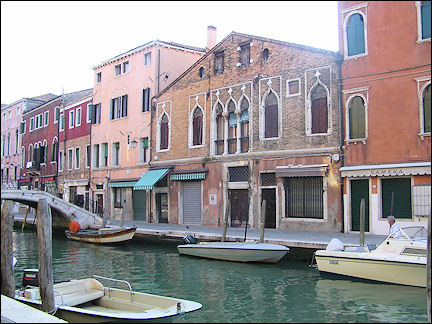
|
With a third day in Venice and a compelling urge to spend more time on the water I headed to Murano (the glass centre), Burano (historically the lace centre) and Torcello (historically the most important island in the lagoon) for a wonderful day of ferry hopping and musing.
Torcello is inhabited by around 20 people and its decline from a population of 20,000 is palpable. The island is host to a stone throne, said to be that of Attilla the Hun and a basilica housing many features of a Byzantine cathedral. I wandered happily along the canal and through the fields of Torcella, and then returned to the water to retrace my steps, this time spending time in Burano and Murano.
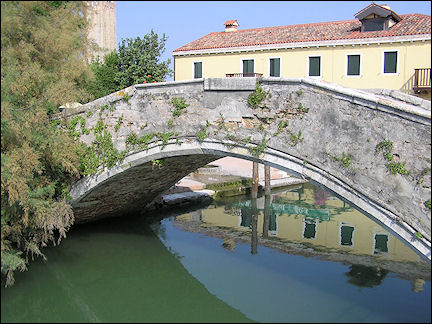
|
Both are beautiful and lively islands and provide plenty of opportunities to eat and relax in surroundings that seem more alive than the main land of Venice.